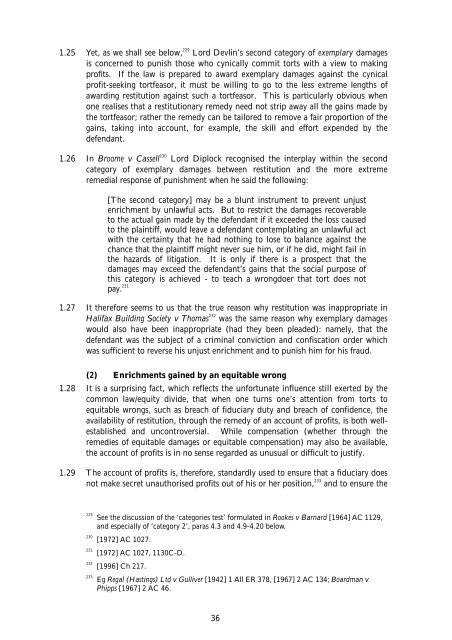Aggravated, Exemplary and Restitutionary ... - Law Commission
Aggravated, Exemplary and Restitutionary ... - Law Commission
Aggravated, Exemplary and Restitutionary ... - Law Commission
Create successful ePaper yourself
Turn your PDF publications into a flip-book with our unique Google optimized e-Paper software.
1.25 Yet, as we shall see below, 229<br />
Lord Devlin’s second category of exemplary damages<br />
is concerned to punish those who cynically commit torts with a view to making<br />
profits. If the law is prepared to award exemplary damages against the cynical<br />
profit-seeking tortfeasor, it must be willing to go to the less extreme lengths of<br />
awarding restitution against such a tortfeasor. This is particularly obvious when<br />
one realises that a restitutionary remedy need not strip away all the gains made by<br />
the tortfeasor; rather the remedy can be tailored to remove a fair proportion of the<br />
gains, taking into account, for example, the skill <strong>and</strong> effort expended by the<br />
defendant.<br />
1.26 In Broome v Cassell 230<br />
Lord Diplock recognised the interplay within the second<br />
category of exemplary damages between restitution <strong>and</strong> the more extreme<br />
remedial response of punishment when he said the following:<br />
[The second category] may be a blunt instrument to prevent unjust<br />
enrichment by unlawful acts. But to restrict the damages recoverable<br />
to the actual gain made by the defendant if it exceeded the loss caused<br />
to the plaintiff, would leave a defendant contemplating an unlawful act<br />
with the certainty that he had nothing to lose to balance against the<br />
chance that the plaintiff might never sue him, or if he did, might fail in<br />
the hazards of litigation. It is only if there is a prospect that the<br />
damages may exceed the defendant’s gains that the social purpose of<br />
this category is achieved - to teach a wrongdoer that tort does not<br />
pay. 231<br />
1.27 It therefore seems to us that the true reason why restitution was inappropriate in<br />
Halifax Building Society v Thomas 232<br />
was the same reason why exemplary damages<br />
would also have been inappropriate (had they been pleaded): namely, that the<br />
defendant was the subject of a criminal conviction <strong>and</strong> confiscation order which<br />
was sufficient to reverse his unjust enrichment <strong>and</strong> to punish him for his fraud.<br />
(2) Enrichments gained by an equitable wrong<br />
1.28 It is a surprising fact, which reflects the unfortunate influence still exerted by the<br />
common law/equity divide, that when one turns one’s attention from torts to<br />
equitable wrongs, such as breach of fiduciary duty <strong>and</strong> breach of confidence, the<br />
availability of restitution, through the remedy of an account of profits, is both wellestablished<br />
<strong>and</strong> uncontroversial. While compensation (whether through the<br />
remedies of equitable damages or equitable compensation) may also be available,<br />
the account of profits is in no sense regarded as unusual or difficult to justify.<br />
1.29 The account of profits is, therefore, st<strong>and</strong>ardly used to ensure that a fiduciary does<br />
not make secret unauthorised profits out of his or her position, 233<br />
<strong>and</strong> to ensure the<br />
229 See the discussion of the ‘categories test’ formulated in Rookes v Barnard [1964] AC 1129,<br />
<strong>and</strong> especially of ‘category 2’, paras 4.3 <strong>and</strong> 4.9-4.20 below.<br />
230 [1972] AC 1027.<br />
231 [1972] AC 1027, 1130C-D.<br />
232 [1996] Ch 217.<br />
233 Eg Regal (Hastings) Ltd v Gulliver [1942] 1 All ER 378, [1967] 2 AC 134; Boardman v<br />
Phipps [1967] 2 AC 46.<br />
36
















